现金流对营运资本管理的影响和资金投资【外文翻译】复习进程
现金流与营运资本管理
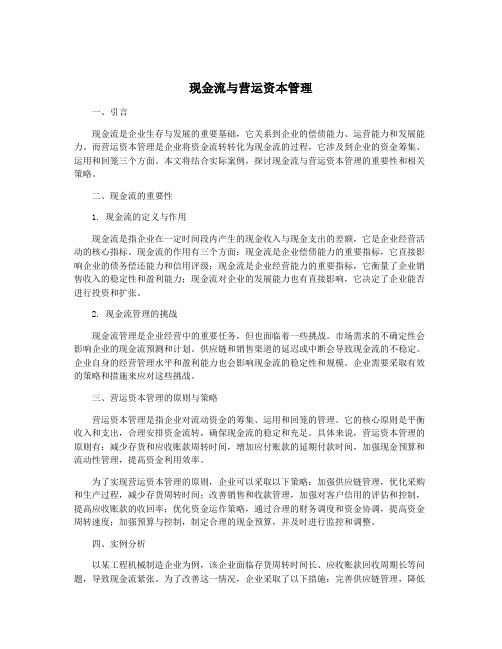
现金流与营运资本管理一、引言现金流是企业生存与发展的重要基础,它关系到企业的偿债能力、运营能力和发展能力。
而营运资本管理是企业将资金流转转化为现金流的过程,它涉及到企业的资金筹集、运用和回笼三个方面。
本文将结合实际案例,探讨现金流与营运资本管理的重要性和相关策略。
二、现金流的重要性1. 现金流的定义与作用现金流是指企业在一定时间段内产生的现金收入与现金支出的差额,它是企业经营活动的核心指标。
现金流的作用有三个方面:现金流是企业偿债能力的重要指标,它直接影响企业的债务偿还能力和信用评级;现金流是企业经营能力的重要指标,它衡量了企业销售收入的稳定性和盈利能力;现金流对企业的发展能力也有直接影响,它决定了企业能否进行投资和扩张。
2. 现金流管理的挑战现金流管理是企业经营中的重要任务,但也面临着一些挑战。
市场需求的不确定性会影响企业的现金流预测和计划。
供应链和销售渠道的延迟或中断会导致现金流的不稳定。
企业自身的经营管理水平和盈利能力也会影响现金流的稳定性和规模。
企业需要采取有效的策略和措施来应对这些挑战。
三、营运资本管理的原则与策略营运资本管理是指企业对流动资金的筹集、运用和回笼的管理。
它的核心原则是平衡收入和支出,合理安排资金流转,确保现金流的稳定和充足。
具体来说,营运资本管理的原则有:减少存货和应收账款周转时间,增加应付账款的延期付款时间,加强现金预算和流动性管理,提高资金利用效率。
为了实现营运资本管理的原则,企业可以采取以下策略:加强供应链管理,优化采购和生产过程,减少存货周转时间;改善销售和收款管理,加强对客户信用的评估和控制,提高应收账款的收回率;优化资金运作策略,通过合理的财务调度和资金协调,提高资金周转速度;加强预算与控制,制定合理的现金预算,并及时进行监控和调整。
四、实例分析以某工程机械制造企业为例,该企业面临存货周转时间长、应收账款回收周期长等问题,导致现金流紧张。
为了改善这一情况,企业采取了以下措施:完善供应链管理,降低存货采购成本和库存规模;加强销售管理,提高销售收款的速度和效率;优化资金运作,加强对应付账款的管理和控制,延长付款周期;制定合理的现金预算和流动性管理策略,及时调整和控制资金使用。
现金流量与营运资本管理
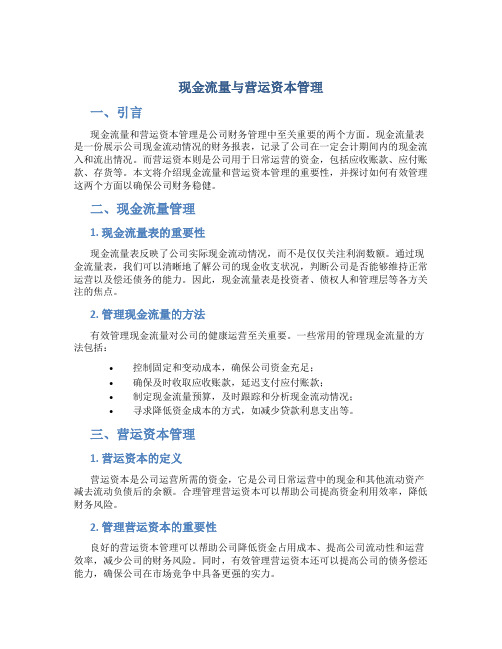
现金流量与营运资本管理一、引言现金流量和营运资本管理是公司财务管理中至关重要的两个方面。
现金流量表是一份展示公司现金流动情况的财务报表,记录了公司在一定会计期间内的现金流入和流出情况。
而营运资本则是公司用于日常运营的资金,包括应收账款、应付账款、存货等。
本文将介绍现金流量和营运资本管理的重要性,并探讨如何有效管理这两个方面以确保公司财务稳健。
二、现金流量管理1. 现金流量表的重要性现金流量表反映了公司实际现金流动情况,而不是仅仅关注利润数额。
通过现金流量表,我们可以清晰地了解公司的现金收支状况,判断公司是否能够维持正常运营以及偿还债务的能力。
因此,现金流量表是投资者、债权人和管理层等各方关注的焦点。
2. 管理现金流量的方法有效管理现金流量对公司的健康运营至关重要。
一些常用的管理现金流量的方法包括:•控制固定和变动成本,确保公司资金充足;•确保及时收取应收账款,延迟支付应付账款;•制定现金流量预算,及时跟踪和分析现金流动情况;•寻求降低资金成本的方式,如减少贷款利息支出等。
三、营运资本管理1. 营运资本的定义营运资本是公司运营所需的资金,它是公司日常运营中的现金和其他流动资产减去流动负债后的余额。
合理管理营运资本可以帮助公司提高资金利用效率,降低财务风险。
2. 管理营运资本的重要性良好的营运资本管理可以帮助公司降低资金占用成本、提高公司流动性和运营效率,减少公司的财务风险。
同时,有效管理营运资本还可以提高公司的债务偿还能力,确保公司在市场竞争中具备更强的实力。
3. 营运资本管理的方法要进行有效的营运资本管理,公司可以考虑以下方法:•优化应收账款管理,及时追踪客户付款情况;•管理存货水平,避免过度库存造成资金占用;•控制应付账款,尽量延迟付款以提高资金利用效率;•确保合理的现金流动,避免资金断层导致运营困难。
四、结论现金流量和营运资本管理是公司财务管理中的重要组成部分,直接影响着公司的长期发展和稳健性。
现金流与营运资本管理
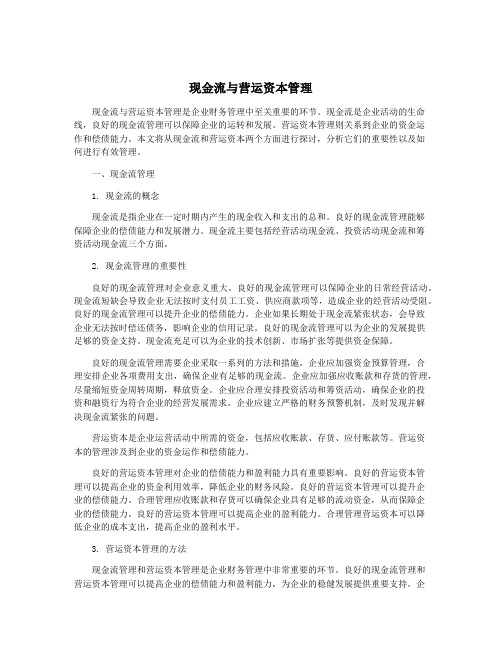
现金流与营运资本管理现金流与营运资本管理是企业财务管理中至关重要的环节。
现金流是企业活动的生命线,良好的现金流管理可以保障企业的运转和发展。
营运资本管理则关系到企业的资金运作和偿债能力。
本文将从现金流和营运资本两个方面进行探讨,分析它们的重要性以及如何进行有效管理。
一、现金流管理1. 现金流的概念现金流是指企业在一定时期内产生的现金收入和支出的总和。
良好的现金流管理能够保障企业的偿债能力和发展潜力。
现金流主要包括经营活动现金流、投资活动现金流和筹资活动现金流三个方面。
2. 现金流管理的重要性良好的现金流管理对企业意义重大。
良好的现金流管理可以保障企业的日常经营活动。
现金流短缺会导致企业无法按时支付员工工资、供应商款项等,造成企业的经营活动受阻。
良好的现金流管理可以提升企业的偿债能力。
企业如果长期处于现金流紧张状态,会导致企业无法按时偿还债务,影响企业的信用记录。
良好的现金流管理可以为企业的发展提供足够的资金支持。
现金流充足可以为企业的技术创新、市场扩张等提供资金保障。
良好的现金流管理需要企业采取一系列的方法和措施。
企业应加强资金预算管理,合理安排企业各项费用支出,确保企业有足够的现金流。
企业应加强应收账款和存货的管理,尽量缩短资金周转周期,释放资金。
企业应合理安排投资活动和筹资活动,确保企业的投资和融资行为符合企业的经营发展需求。
企业应建立严格的财务预警机制,及时发现并解决现金流紧张的问题。
营运资本是企业运营活动中所需的资金,包括应收账款、存货、应付账款等。
营运资本的管理涉及到企业的资金运作和偿债能力。
良好的营运资本管理对企业的偿债能力和盈利能力具有重要影响。
良好的营运资本管理可以提高企业的资金利用效率,降低企业的财务风险。
良好的营运资本管理可以提升企业的偿债能力。
合理管理应收账款和存货可以确保企业具有足够的流动资金,从而保障企业的偿债能力。
良好的营运资本管理可以提高企业的盈利能力。
合理管理营运资本可以降低企业的成本支出,提高企业的盈利水平。
现金流量管理对企业管理的影响

现金流量管理对企业管理的影响现金流量是企业经营活动中最重要的资金指标之一,对于企业的健康发展和可持续经营至关重要。
现金流量管理是指企业通过科学有效地管理和控制现金流量,以确保企业能够正常运营并及时足额地履行债务和支付各项费用。
现金流量管理不仅对企业的日常经营决策和战略规划产生影响,还能提高企业的融资能力、降低财务风险、增强盈利能力和提升企业价值。
本文将从以上几个方面论述现金流量管理对企业管理的影响。
一、现金流量管理对日常经营决策的影响1. 经营活动的资金需求分析:企业经营活动需要足够的现金来购买原材料、支付工资和其他费用。
通过合理分析和预测现金流量情况,企业可以更好地制定采购计划、生产计划和人员安排,避免出现资金断裂的情况,保持正常运营。
2. 项目投资决策的支持:现金流量管理可以帮助企业评估项目的金融可行性。
通过计算项目的现金流入和现金流出,企业可以判断项目是否能够盈利,从而决定是否进行投资。
同时,对现金流量进行监控和管理,能够及时发现项目运营中的风险和问题,避免项目亏损。
3. 资金计划和预算编制:企业通过现金流量管理可以制定合理的资金计划和预算。
根据现金流量的动态变化,企业可以调整资金的使用和分配,合理安排资金的进出,避免出现“资金闲置”或“资金短缺”的问题,提高资金使用效率。
二、现金流量管理对战略规划的影响1. 融资能力的提升:现金流量管理可以帮助企业提升融资能力,降低融资成本。
良好的现金流量管理能够证明企业有足够的现金流入和偿债能力,有助于吸引投资者和金融机构的资金支持。
同时,企业可以通过优化现金流量使用,减少外部融资需求,降低融资风险。
2. 财务风险的降低:现金流量管理可以有效降低企业的财务风险。
通过合理管理现金流入和流出,企业能够避免出现偿债困难、逾期还款和支付延误等风险,保证企业的财务稳定和信誉良好,降低财务风险,增强市场竞争力。
3. 盈利能力的增强:现金流量管理可以提升企业的盈利能力。
现金流量分析与营运资本管理

现金流量分析与营运资本管理在企业管理中,现金流量分析和营运资本管理是至关重要的财务管理工具,可以帮助企业有效规划和控制资金运作,确保企业持续稳定地发展。
本文将深入探讨现金流量分析和营运资本管理的重要性,以及如何有效应用这些工具来优化企业的财务状况。
现金流量分析现金流量分析是评估企业现金收入和支出情况的过程,通过对现金流入和流出的预测和监控,企业可以更好地管理自身的资金流动。
一般来说,现金流量分析包括经营活动、投资活动和筹资活动三个方面。
经营活动经营活动是企业核心的现金流来源,主要包括销售商品或提供服务所获得的现金收入以及支付给供应商、员工和其他经营成本的现金支出。
通过对经营活动现金流量的分析,企业可以及时发现经营效益的变化,制定更好的经营决策。
投资活动投资活动涉及企业对资产的购买和出售,以及对其他企业的投资。
投资活动的现金流量分析可以帮助企业评估投资的风险和回报,从而优化投资组合,实现资金的最大增值。
筹资活动筹资活动是企业为融资目的而进行的现金流动,包括向投资者发行股票、债券或借款等方式。
通过筹资活动现金流量的分析,企业可以评估自身的融资能力,合理安排融资结构,降低财务风险。
营运资本管理营运资本管理是确保企业日常经营活动顺利进行的关键环节,主要涉及企业的应收账款、应付账款、存货等资金的管理与控制。
合理的营运资本管理可以帮助企业避免资金周转不畅、降低资金成本、提高盈利能力。
应收账款管理有效的应收账款管理可以加快资金回笼速度,降低坏账风险,提高企业现金流的稳定性。
企业可以通过建立明晰的应收账款管理制度,及时跟踪客户付款情况,减少逾期账款的发生。
应付账款管理合理的应付账款管理可以延长企业的付款周期,优化资金利用效率。
企业可以与供应商协商延长付款期限,减少短期资金压力,提高自身的流动性。
存货管理有效的存货管理可以避免存货积压和过度库存现象,在保证供应链畅通的同时降低存储成本。
企业可以通过精细化的存货管理,及时调整库存水平,确保生产与销售的平衡。
现金流与营运资本管理

现金流与营运资本管理
现金流与营运资本管理是企业日常经营活动中非常重要的两个方面。
现金流是企业运营中的现金流入和流出的总和,是企业经营活动的重要指标之一。
营运资本则是指企业未支付的成本和未收取的收入之和,它是企业运营的资本投入和回报的具体体现。
现金流与营运资本管理对企业的经营和发展有着重要的影响,下面将从以下几个方面进行详细介绍。
现金流与营运资本管理对企业的融资和偿还能力有着直接的影响。
现金流的稳定与否决定了企业是否具备偿还债务的能力,而营运资本的管理则直接影响了企业的融资能力。
如果现金流不稳定或者营运资本不足,企业很难获得持续的融资支持或者偿还债务,这将导致企业的经营困难甚至倒闭。
现金流与营运资本管理对企业的经营风险和经营效率有着重要的影响。
现金流的管理能力直接影响了企业的资金运作效率,如果企业现金流过低或者现金流周期过长,将会导致企业融资成本的上升、经营活动的受限以及经营风险的增加。
营运资本的管理能力也直接决定了企业的经营效率,合理的管理能够降低资金占用成本,提高使用效率,从而实现对企业经营活动的有效控制。
现金流与营运资本管理对企业的经营和发展具有重要的影响。
通过科学合理的管理,可以降低企业的经营风险,提高资金利用效率,增强企业的盈利能力和竞争力。
企业管理者应该高度重视现金流与营运资本的管理,制定有效的管理策略和措施,确保企业的健康发展。
营运资金管理 中英双语文献

营运资金管理中英双语文献营运资金是企业用于日常运营的资金,包括现金、存货、应收账款等。
良好的营运资金管理可以确保企业正常运转和资金充足,同时还能减少财务风险和成本。
以下是关于营运资金管理的中英双语文献:1. 《营运资金管理的重要性及其对企业运营的影响》(The Importance of Working Capital Management and Its Impact on Business Operations)本文介绍了营运资金管理的概念和重要性,探讨了如何优化营运资金管理以提高企业效率和盈利能力。
2. 《营运资金管理策略的选择与实施》(Selection and Implementation of Working Capital Management Strategies) 该文讨论了不同的营运资金管理策略,并提供了实施这些策略的具体步骤和技巧,以帮助企业实现资金最大化利用。
3. 《营运资金管理与企业绩效》(Working Capital Management and Firm Performance)该研究探讨了营运资金管理与企业绩效之间的关系,并证实了营运资金管理对企业绩效的重要性。
4. 《营运资金管理中的财务风险与控制》(Financial Risk and Control in Working Capital Management)该文描述了营运资金管理中的财务风险,并提出了相应的控制措施,以帮助企业降低财务风险并增强资金管理能力。
5. 《营运资金管理中的现金流预测与控制》(Cash Flow Forecasting and Control in Working Capital Management) 本文介绍了现金流预测在营运资金管理中的重要性,并提供了现金流预测的方法和技巧,以帮助企业更好地管理资金。
以上是关于营运资金管理的中英双语文献,这些文献可以帮助企业了解营运资金管理的重要性和实施方法,提高企业的资金使用效率和管理能力。
现金流与营运资本管理

现金流与营运资本管理
现金流
现金流是指企业或个人在某一时期内流入和流出的现金金额。
在企业运营中,现金流是一种非常重要的财务指标,因为现金流对于企业的生存和发展至关重要。
在资金短缺的时期,现金流的管理将变得尤为重要。
现金流一般分为净现金流和经营现金流两种。
净现金流是指企业收到的现金总量减去其支出的现金总量。
而经营现金流是指企业日常经营活动中的现金流量,在这些活动中,包括销售商品或服务、采购和存储原材料等方面的现金流。
营运资本是指企业日常运营所需要的资本,包括存货、应收账款和应付账款等。
营运资本的管理对于企业维持正常运营和经营成功非常重要。
企业需要确保营运资本的充足,确保在满足日常需求的同时还能够满足未来的扩张和发展。
对于营运资本的管理,需要从以下几个方面考虑:
1. 存货管理
存货是企业最主要的营运资本,因此,它的管理对于企业的经营至关重要。
存货的过剩或不足都会影响企业的正常经营。
因此,企业应该根据市场需求来合理控制存货的量。
2. 应收账款管理
应收账款是指企业销售商品或提供服务后未收回的钱款。
因此,应收账款的管理直接关系到企业的现金流问题。
企业应该设定合理的信用政策,并控制客户的账款周期,以保证企业的现金流畅通。
应付账款是指企业在交易过程中需要支付的账款,如采购原材料、支付货款等。
企业需要根据实际情况制定合理的应付账款管理政策,以保证企业的运营资金充足。
综上所述,现金流与营运资本管理是企业日常经营的重要环节。
企业应该优化自己的管理模式,加强对现金流和营运资本的管理,以此来确保企业的稳定经营和健康发展。
现金流与营运资本管理
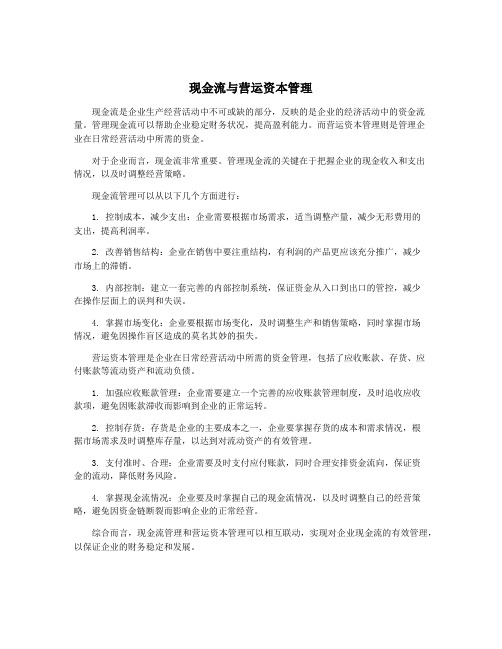
现金流与营运资本管理现金流是企业生产经营活动中不可或缺的部分,反映的是企业的经济活动中的资金流量。
管理现金流可以帮助企业稳定财务状况,提高盈利能力。
而营运资本管理则是管理企业在日常经营活动中所需的资金。
对于企业而言,现金流非常重要。
管理现金流的关键在于把握企业的现金收入和支出情况,以及时调整经营策略。
现金流管理可以从以下几个方面进行:1. 控制成本,减少支出:企业需要根据市场需求,适当调整产量,减少无形费用的支出,提高利润率。
2. 改善销售结构:企业在销售中要注重结构,有利润的产品更应该充分推广,减少市场上的滞销。
3. 内部控制:建立一套完善的内部控制系统,保证资金从入口到出口的管控,减少在操作层面上的误判和失误。
4. 掌握市场变化:企业要根据市场变化,及时调整生产和销售策略,同时掌握市场情况,避免因操作盲区造成的莫名其妙的损失。
营运资本管理是企业在日常经营活动中所需的资金管理,包括了应收账款、存货、应付账款等流动资产和流动负债。
1. 加强应收账款管理:企业需要建立一个完善的应收账款管理制度,及时追收应收款项,避免因账款滞收而影响到企业的正常运转。
2. 控制存货:存货是企业的主要成本之一,企业要掌握存货的成本和需求情况,根据市场需求及时调整库存量,以达到对流动资产的有效管理。
3. 支付准时、合理:企业需要及时支付应付账款,同时合理安排资金流向,保证资金的流动,降低财务风险。
4. 掌握现金流情况:企业要及时掌握自己的现金流情况,以及时调整自己的经营策略,避免因资金链断裂而影响企业的正常经营。
综合而言,现金流管理和营运资本管理可以相互联动,实现对企业现金流的有效管理,以保证企业的财务稳定和发展。
现金流与营运资本管理
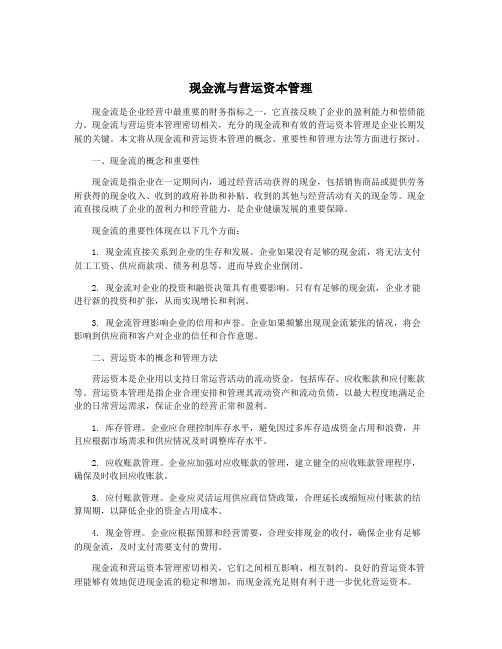
现金流与营运资本管理现金流是企业经营中最重要的财务指标之一,它直接反映了企业的盈利能力和偿债能力。
现金流与营运资本管理密切相关,充分的现金流和有效的营运资本管理是企业长期发展的关键。
本文将从现金流和营运资本管理的概念、重要性和管理方法等方面进行探讨。
一、现金流的概念和重要性现金流是指企业在一定期间内,通过经营活动获得的现金,包括销售商品或提供劳务所获得的现金收入、收到的政府补助和补贴、收到的其他与经营活动有关的现金等。
现金流直接反映了企业的盈利力和经营能力,是企业健康发展的重要保障。
现金流的重要性体现在以下几个方面:1. 现金流直接关系到企业的生存和发展。
企业如果没有足够的现金流,将无法支付员工工资、供应商款项、债务利息等,进而导致企业倒闭。
2. 现金流对企业的投资和融资决策具有重要影响。
只有有足够的现金流,企业才能进行新的投资和扩张,从而实现增长和利润。
3. 现金流管理影响企业的信用和声誉。
企业如果频繁出现现金流紧张的情况,将会影响到供应商和客户对企业的信任和合作意愿。
二、营运资本的概念和管理方法营运资本是企业用以支持日常运营活动的流动资金,包括库存、应收账款和应付账款等。
营运资本管理是指企业合理安排和管理其流动资产和流动负债,以最大程度地满足企业的日常营运需求,保证企业的经营正常和盈利。
1. 库存管理。
企业应合理控制库存水平,避免因过多库存造成资金占用和浪费,并且应根据市场需求和供应情况及时调整库存水平。
2. 应收账款管理。
企业应加强对应收账款的管理,建立健全的应收账款管理程序,确保及时收回应收账款。
3. 应付账款管理。
企业应灵活运用供应商信贷政策,合理延长或缩短应付账款的结算周期,以降低企业的资金占用成本。
4. 现金管理。
企业应根据预算和经营需要,合理安排现金的收付,确保企业有足够的现金流,及时支付需要支付的费用。
现金流和营运资本管理密切相关,它们之间相互影响、相互制约。
良好的营运资本管理能够有效地促进现金流的稳定和增加,而现金流充足则有利于进一步优化营运资本。
现金流与营运资本管理

电话:021-60837966
中国上海市共和路 268 号企业广场 18 楼 传真:021-60837901 邮箱:service@
系统财务培训提供商
课程内容 第 1 天 现金流量管理
一、 现金流量在企业财务管理中的重要性
第 2 天 营运资本管理
四、 现金流量的量化计算与分析
-
初步认识企业现金流量活动 利润与现金流量之间的关系 不同角度看现金流量——股东、债权人、经营 者
-
经营活动、投资活动、融资活动现金流量的计 算 分析企业偿债能力 自由现金流量计算与分析 分析经营活动现金净流量中存在的问题
二、 企业现金流入行系统 日常各种现金流出的管理 关注付款优先次序 现金管理的内部控制及程序
-
公司长期现金流规划 投资项目的现金流预测 最佳现金持有量预测 企业经营管理中的现金流量预算——年度、季 度、月度、周
企业的倒闭或破产往往不是没有盈利,而是现金流的断裂。因此,现金流管理水平往往是企 业存亡的决定要素。在当今复杂多变的经济环境下,尤其当经济危机来袭,资金周转危机往往是企 业面临危机的直接导火索。 高顿秉承系统培训的理念, 全方位为您提供现金流量和营运资本管理的 方法和技术,掌握现金流管理的关键要素,紧随时代发展和变化,将最先进、最适合的财务管理知 识带给您,为企业打造丰盛的培训盛宴。
课程收益
了解现金流量为企业命脉的原因 掌握量化现金流量的基本方法 提升预测未来现金流量的能力 提高资金使用效率 学会建立自己公司的现金流量管理机制 理解并熟练使用财务报表,并能通过分析企业的财务报表以明确数据背后的经济内涵和实质
课程对象
董事长、总经理等企业中高层管理人员 财务总监、控制总监、投资总监 财务经理、会计经理、现金经理、资金经理、内审经理 财务人员及其他部门相关人员
现金流与营运资本管理

现金流与营运资本管理现金流与营运资本管理是企业管理中十分重要的一部分,能够对企业的财务状况和经营活动产生深远的影响。
本文将围绕现金流与营运资本管理进行详细探讨。
现金流是企业生存和发展的动力。
现金流主要指的是企业在一定时间内所产生的现金收入与支出的差额。
良好的现金流管理能够确保企业有足够的流动性来应对日常经营活动和应急情况。
现金流也是评价企业健康状况的重要指标之一。
企业如果长期现金流为负,有可能导致企业资金链断裂,甚至引发倒闭。
要有效管理现金流,需要注意以下几个方面。
应制定合理的预算。
通过制定现金流预算,企业能够更好地掌握收入和支出的情况,及时采取措施来保持现金流平稳。
应加强资金往来的管理。
包括催收账款、延迟付款、合理安排资金使用等。
企业还可以通过引入银行等金融机构的贷款来保持现金流的充裕。
应加强现金流的跟踪与分析。
通过对现金流的监控和分析,可以及时发现问题,采取相应的调整措施。
营运资本管理是确保企业能够按时履行债务和保持良好运营的重要手段。
营运资本主要包括流动资产和流动负债,涉及到企业的库存管理、应收账款管理等。
优化营运资本管理可以有效减少企业的流动性风险、提高资金使用效率。
企业不仅要关注自身的资金运作,还要积极与供应商、客户等关系密切的利益相关方进行合作。
营运资本管理的关键在于合理配置企业的流动资金。
企业应合理控制库存。
过高的库存会导致资金占用过多,降低流动性,过低的库存则可能导致供应不足,影响生产正常进行。
企业应加强应收账款管理。
包括准确掌握客户的信用状况,及时催收款项,确保资金的及时回收。
企业还可以通过与供应商签订长期供应合同、采用先付款后供货等方式来优化供应链管理,减少流动资金的占用。
现金流与营运资本管理

现金流与营运资本管理现金流与营运资本管理一直是企业财务管理的核心。
现金流是企业最基本的生存资源,维持良好的现金流是企业生存和发展的基础。
营运资本是企业在经营活动中所需的资产和负债,包括应收账款、应付账款、存货等。
营运资本的优化能够降低企业风险,提高资产回报率。
本文将介绍现金流与营运资本管理的重要性以及一些方法和技巧。
一、现金流管理的重要性现金流是企业最基本的生存资源,维持良好的现金流是企业生存和发展的基础。
良好的现金流管理可以保证企业的稳健运作和强大抗风险能力。
如果企业的现金流管理不当,将导致企业现金流紧张,甚至出现生产经营异常,信誉度下降,导致恶性循环和扩大风险。
因此,企业必须积极管理现金流。
现金流管理的主要目标是确保企业的现金收入多于支出。
为了实现这一目标,企业需要密切关注经营活动、投资活动和筹资活动。
经营活动包括销售产品或服务所得到的现金流。
投资活动包括购买或出售固定资产、投资证券以及债权和债务等的现金流。
筹资活动包括募集资本、发行债券、支付股息和偿还债务等的现金流。
优化现金流还需要注意以下几点:1、加快货款收回,缩短应收账款的周转时间。
可以通过优化销售策略,减少信用销售给客户,加快收款周期和减少预付款等来实现。
2、合理控制存货,减少库存,缩短存货周期。
可通过加强供应链管理,减少过多备货和延长付款周期等方式实现。
3、延长应付账款支付时间,适当延长账期,减少支出。
可以考虑与供应商协商付款周期,以便延长支付时间。
1、提高现金流转率现金流转率是衡量企业流动性和偿债能力的重要指标。
提高现金流转率有助于降低经营风险和财务风险。
通过优化存货、应收账款和应付账款的结构,可以提高现金流转率。
2、负债结构优化企业应根据自身情况,设计合理的负债结构。
在融资方面,企业应根据自身情况选择合适的融资方式,如发行债券、股权融资等,同时注意借款期限、利率等要素。
在应付账款方面,企业可以与供应商协商合理的账期,提高账款支付的灵活性和延长账款支付时间。
现金流与营运资本管理

现金流与营运资本管理在企业管理中,现金流与营运资本管理是至关重要的一环。
良好的现金流管理和有效的营运资本管理能够确保企业在经营过程中有足够的流动资金来支撑日常运营,并且能够保持盈利能力。
本文将对现金流与营运资本管理进行深入探讨,包括定义,重要性以及相关策略和技巧。
现金流是指企业经营活动产生的现金流入和流出。
“活动”包括销售商品和提供服务的收款,支付供应商和员工的费用,支付利息和税款等等。
良好的现金流管理能够确保企业有足够的现金来支付日常费用,避免因为流动资金紧缺而导致的经营风险。
良好的现金流管理也能够支持企业的成长和发展,为企业提供投资和扩张的资金。
营运资本管理是指企业管理其流动资产和流动负债的活动。
流动资产包括现金、应收账款、存货等,流动负债包括应付账款、短期借款等。
有效的营运资本管理能够使企业实现流动资金的最优配置,提高资金利用效率,降低企业的财务风险,提升企业的盈利能力。
现金流与营运资本管理对企业的重要性不言而喻。
对于大型企业而言,现金流与营运资本管理关系到企业的生存和发展;对于中小型企业而言,良好的现金流和营运资本管理更是其持续经营的基石。
为了有效管理现金流与营运资本,企业需要采取相应的策略和技巧。
企业需要制定合理的预算和计划,合理分配资金用于日常经营和投资活动。
企业需要优化资金周转周期,缩短应收账款周期,延长应付账款周期,以提高资金利用效率。
企业需要建立健全的内部控制制度,对资金的使用和流动进行监控和管理。
企业需要及时进行现金流分析和经营资本分析,及时发现并解决存在的问题。
除了以上的一些基本策略和技巧外,企业还可以运用一些金融工具和产品来管理现金流和营运资本。
企业可以通过银行贷款来融资,以提高资金的周转速度;企业可以通过保理来加速账款的收回,提高现金流入;企业还可以通过期货和远期合约来对冲货币和利率风险,保护企业的流动资金。
现金流与营运资本管理

现金流与营运资本管理现金流和营运资本管理是企业财务管理中至关重要的两个方面。
现金流是企业经营活动中最重要的一个财务指标,它反映了企业在一定时期内从经营活动中获得的现金收入和流出的现金支出。
营运资本管理则是指企业通过管理资产和负债,以最大化现金流并确保企业运营的持续性和稳定性。
本文将讨论现金流和营运资本管理在企业财务管理中的重要性以及如何有效管理现金流和营运资本。
现金流的重要性现金流的管理对企业的生存和发展至关重要。
现金流不仅影响着企业的经营活动,还直接关系到企业的偿债能力、发展能力和盈利能力。
一家企业如果没有足够的现金流,将难以维持日常经营和发展需求,甚至导致资金链断裂。
企业必须时刻关注现金流的情况,并采取有效的手段来管理现金流。
企业需要合理预测现金流。
通过分析企业的经营状况和市场环境,可以对企业未来一段时间内的现金流做出合理的预测。
这种预测可以帮助企业有针对性地制定资金管理计划,以应对可能出现的资金紧张情况。
企业需要有效控制现金流的支出。
这意味着企业需要审慎管理各项支出,包括生产成本、销售费用、财务费用等。
企业可以通过优化生产流程、合理控制库存、降低运营成本等方式来降低支出,并确保实现良好的盈利水平。
企业还需要合理安排资金的使用。
企业要确保资金的合理使用,不仅要保持足够的流动资金,还要合理规划投资和融资活动,确保企业资金的有效利用和生成更多的现金流。
营运资本管理的重要性营运资本管理是指企业通过管理在营运过程中所持有的各项资产和负债,来实现最佳的资金利用效果,以确保企业的定期运营和发展。
营运资本管理的好坏直接影响着企业的盈利能力和偿债能力。
企业需要合理配置资产。
合理配置资产可以帮助企业降低资产占用成本,提高资产周转率,从而释放更多资金用于企业的发展和运营。
企业可以通过控制存货水平、提高应收账款回收速度、合理安排固定资产的使用等方式来实现资产的最佳配置。
企业需要合理管理负债。
管理负债不仅能够降低企业的财务风险,还能够减少企业的财务成本。
(现金流量分析)现金流量与营运资本管理

(现金流量分析)现金流量与营运资本管理第壹讲决定企业生存的现金流什么是现金流(壹)现金流的概念现金流量(CashFlow),又称现金流转或现金流动,是指企业于壹定会计期间按照现金收付实现制,通过壹定经济活动(包括运营活动、投资活动、筹资活动和非经常性项目)而产生的现金流入(CashinFlow)、现金流出(CashOutFlow)及其差量情况的总称。
(二)现金流的分类企业现金流(量)按其来源和用途的不同分为:运营活动的现金流(量);投资活动的现金流(量);筹资活动的现金流(量)。
1.运营活动的现金流运营活动的现金流是由企业商品生产和交易活动产生的现金流入和流出。
运营活动的现金流入主要包括:销售商品、提供劳务所收到的现金。
运营活动的现金流出主要包括:购买商品、接受劳务支付的现金;发放工资支付的现金;支付的各项税费等。
2.投资活动的现金流投资活动的现金流是由企业对外投资和对内的固定资产、无形资产投资形成的现金流入和流出。
投资活动的现金流入主要包括:收回投资收到的现金,处置固定资产、无形资产收回的现金等。
投资活动的现金流出主要包括:购置固定资产、无形资产所支付的现金;对外投资支付的现金等。
3.筹资活动的现金流筹资活动的现金流是由企业筹措资金、偿仍债务、支付资金成本形成的现金流入和流出。
筹资活动的现金流入主要包括:吸引投资收到的现金;借款收到的现金等。
筹资活动的现金流出主要包括:偿仍债务支付的现金;支付股利、利润、利息支付的现金等。
通过对企业现金流的介绍,能够见出,企业现金流综合地反映了企业运营活动的全过程,从某种意义上说,企业的运营活动就是企业资金的运动。
现金流于企业中的重要作用(壹)资金是企业的血液企业就像是壹个人,人能够生存的前提条件是保证血液循环的顺畅。
对企业来说,现金就是企业的血液,现金流量就是企业的血液循环。
企业要想生存,正常开展生产运营活动,就必须有现金,必须保证现金流动的顺畅。
随着企业参和的运营越来越多,竞争越来越激烈,对现金资产及现金流量的需求也就越大。
- 1、下载文档前请自行甄别文档内容的完整性,平台不提供额外的编辑、内容补充、找答案等附加服务。
- 2、"仅部分预览"的文档,不可在线预览部分如存在完整性等问题,可反馈申请退款(可完整预览的文档不适用该条件!)。
- 3、如文档侵犯您的权益,请联系客服反馈,我们会尽快为您处理(人工客服工作时间:9:00-18:30)。
外文翻译原文The Cash Flow Implications of Managing Working Capital and Capital Investment Material Source: Journal of Business & Economic StudiesAuthor: Russell P. BoisjolyINTRODUCTIONIn recent years major corporations have discovered that there are important cash flow streams available to them if they aggressively manage their working capital accounts (accounts receivable, inventory, accounts payable, and advance payments).While some have argued that cash flows generated through working capital management (improving inventory turnover, aggressive accounts receivable collection policies or supplier management programs, lengthening accounts payable payment periods, etc.) are transitory and, therefore, are not indicative of a fundamental improvement in the internal value creation process (business model), there is limited empirical evidence on whether these practices (a) have changed the underlying probability distributions of the related financial ratios, (b) persisted over several years rather than just 2 or 3 years as implied by Mulford and Ely who purport that changes are transitory or temporary, (c) whether these changes in working capital management policies have impacted market values positively (or negatively) or (d) whether we understand the model for cash flows through the firm adequately to properly conduct empirical tests or forecast cash flows. In addition to managerial policies, one should probably consider changes in technology and changes in the financial environment. Typical DSO or ACP ratios have been radically lowered for most merchandisers by the nearly universal outsourcing of the credit function to credit card companies. Also, the decline of short-term interest rates most certainly affected WC policies during the period in question, making firms less willing to hold cash, and perhaps more willing to increase short-term liabilities.This issue is important to examine not only to determine if changes in management practices have impacted cash flow and value creation, but also to investigate whether ratio norms may have changed and shifted the benchmarks for comparisons between firms. Furthermore, these benchmarks are derived from themeasures of central tendency, but the appropriate use of these benchmarks may be influenced (or biased) by the third (skewness) and fourth (kurtosis) moments of the ratio distributions or industry effects or financial condition. If the bias exists and if the skewness is significant, then the appropriate benchmarks may deviate significantly from the mean, median, or mode. In the past, some researchers excluded “outliers,” e.g., introduced by skewness, from their studies because they were responsible for departures from normality, or they made square root or logarithmic transformations to the data to reestablish or more nearly approach normality. These adjustments theoretically would leave the “benchmarks” unaltered. But, there is substantial evidence the distributions of financial ratios exhibit positive skewness.Previous studies show that distributions of financial ratios exhibit positive skewness and departures from normality. However there have been no attempts to explain the source of the skewness. If management has engaged in practices that should attenuate mean deviations, skewness, or kurtosis, then there may be evidence of this that can be discovered by following firms over time. If distributions have shifted (mean, variance, skewness, and/or kurtosis), then a longitudinal investigation may lead to the establishment of new benchmarks or a new benchmark measurement process, as well as examine the impact on stock price performance.Also, if evidence exists for ratio distribution shifts, then there is cause to reexamine the value creation process and the causality of cash flow generation to value creation. Therefore,the starting point is this longitudinal study of an original sample of 50 firms to determine if distributions have shifted due to changes in working capital management and corporate reinvestment policies.HYPOTHESIS FORMULATIONThis study will look at the distributional properties of several financial ratios tied to the working capital management and capital investment processes of the firm. We will investigate whether there is evidence to support the acceptance of the hypotheses that corporations, especially the largest firms, have become more vigorous in managing their working capital processes or capital investment practices to generate significant improvements in cash flow. Specifically, corporations may have improved the management of accounts receivable, inventory, accounts payable, and advance payments to such an extent that distributions of the related financial ratios have shifted significantly. The distributions also may be more skewed as a result of these changes in corporate policy to accelerate customer payments orextend the period taken to pay suppliers. In addition, corporations may have reduced their reinvestment in the firm as a result of productivity improvements that have been achieved over the last 15 years. The reduction in capital investment may have improved the cash flow position of the firms that experienced significant productivity improvements.Hypothesis 1: There has been a significant improvement in the management of accounts receivable that has led to a significant improvement in the accounts receivable turnover during the period 1990 to 2004.Hypothesis 1a: The distribution of the accounts receivable turnover ratio has become more positively skewed over the 1990-2004 time period.Hypothesis 2: There has been a significant improvement in the management of inventory that has led to a significant improvement in the inventory turnover during the period 1990 to 2004.Hypothesis 2a: The distribution of the inventory turnover ratio has become more positively skewed over the 1990-2004 time period.Hypothesis 3: There has been a significant improvement in the management of accounts payable that has led to a significant decrease in the accounts payable turnover during the period 1990 to 2004.Hypothesis 3a: The distribution of the accounts payable turnover ratio has become more negatively skewed over the 1990-2004 time period.Hypothesis 4: There has been a significant improvement in the management of working capital that has led to a significant improvement in the working capital per share during the period 1990 to 2004.Hypothesis 4a: The distribution of the working capital per share ratio has become more positively skewed over the 1990-2004 time periodHypothesis 5: There has been a significant improvement in the management of working capital that has led to a significant improvement in the cash flow per share during the period 1990 to 2004.Hypothesis 5a: The distribution of the cash flow per share ratio has become more positively skewed over the 1990-2004 time period.Hypothesis 6: There has been a significant improvement in the management of capital expenditures that has led to a significant reduction in the investment ratio during the period 1990 to 2004.Hypothesis 6a: The distribution of the investment ratio has become less positively skewed over the 1990-2004 time period.METHODOLOGYThe empirical tests of these hypotheses were conducted on an original sample of 50 selected at random from the 2005 Fortune 500. We excluded banking institutions and firms from the oil and gas industries since they have unique characteristics and two firms selected at random were eliminated from consideration because they were in bankruptcy. The final viable sample was 48 spread across industries and then Delphi declared bankruptcy during the analysis period. Data were collected from Compustat for the years 1990-2004. After calculating the ratios some firms were eliminated from consideration for individual ratios because they did not have enough data points; because they were acquired or were formed through acquisition during the study period; because they went bankrupt during the study period; or they did not report the data categories needed to calculate a specific ratio during an extended period of time during the study time frame. This sample consisted of non-bank institutions across a variety of industries.The purpose of this study is to determine whether any evidence exists to support the hypotheses stated above. And, if any of the hypotheses are confirmed, this would be one of the first studies to attribute empirical results for financial ratios to changes in management practices over time.EMPIRICAL RESULTSThe data were analyzed and summary statistics were calculated for the sample firms.It reports the means of five financial ratios of interest: accounts receivable turnover, inventory turnover, accounts payable turnover, working capital per share, and cash flow per share. As expected, account receivable turnover and inventory turnover increase monotonically over the 15 year time period. Corporations have focused on improving these measures using a variety of managerial techniques. In managing accounts receivable corporations have utilized techniques such as employing more vigorous collection procedures, offering more generous cash discounts to early payers, paying early and taking discounts even when discounts are not offered, factoring receivables, improving product quality to reduce disputed receivables which tend not to be paid while the dispute remains unresolved, etc. In managing inventory firms have utilized just-in-time procedures with suppliers to reduce storage while awaiting production; make-to-order procedures to reduce work-in-process inventory, lean manufacturing initiatives to reduce the order-to-ship cycle time, quality programs that emphasize design for manufacture to reduce the number of parts, supplier rationalization to reduce the number of suppliers whichreduces the number of different parts, etc. The numbers reported by writer verify that these corporate initiatives and programs seem to be working and improving results.译文现金流对营运资本管理的影响和资金投资资料来源: 商业杂志和经济研究作者:Russell P. Boisjoly相关介绍近年来很多大型企业发现,如果他们能积极地管理其营运资金帐户(应收账款,存货,应付帐款,以及预付款),就能拥有大量的现金流。
